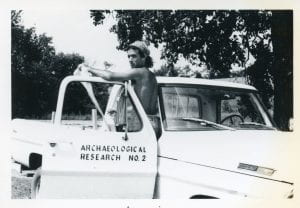 If you want to hear what I do, and skip all the text below, I’ve done a number of podcasts with Steve Rinella at The MeatEater, Clay Newcomb at Bear Grease, as well as with others. You can find links to those here.
If you want to hear what I do, and skip all the text below, I’ve done a number of podcasts with Steve Rinella at The MeatEater, Clay Newcomb at Bear Grease, as well as with others. You can find links to those here.
For readers, here’s the text (= academic) version. My research interests center on the origins, antiquity, and adaptations of the first Americans (Paleoindians), who colonized the North American continent at the end of the Pleistocene (Ice Age). I seek to understand the origins of these populations, when and how they made their way to the Americas, and how these hunter-gatherers met the challenges of moving across and adapting to the vast, initially unknown, ecologically diverse, landscape of late Pleistocene North America, during a time of significant climate change – and how such ‘real-time’ processes might be visible archaeologically tens of thousands of years later.
I have explored those issues through archaeological field work in many areas of North America, but principally on the Great Plains and in the Rocky Mountains of western North America, and on Clovis and especially Folsom-age archaeological sites (including the Folsom type site). My research has also expanded beyond archaeology to include collaborations with geneticists in using modern and ancient DNA to investigate Native American population history, and to work with colleagues in geology, paleoecology, vertebrate paleontology, and isotope geochemistry to investigate Pleistocene climates and environments, particularly the period of the Younger Dryas, which was the millennium-long stage on which much of the peopling process unfolded.
In the course of this work, I have found myself entangled in some of the controversies that swirl around the peopling of the Americas, including claims for purportedly ancient sites; the possible impact (if any) Pleistocene climate changes had on human foragers, and in turn what role (again, if any) humans may have played in Pleistocene faunal extinction; whether the earth was clobbered by a giant space rock that triggered the Younger Dryas and wiped out Clovis peoples and Pleistocene animals (the evidence is questionable at best); and whether the first Americans came from Iberia, not Siberia (a resounding no, on multiple lines of evidence).
Although the details change, controversies over the origins and antiquity of the first Americans are nothing new. In an effort to understand how knowledge of the past is crafted and how controversy in science is resolved, I have spent considerable time (metaphorically-speaking) in the late 19th and early 20th century examining the decades-long debate over human antiquity in North America that involved the best and brightest of several generations of archaeologists, glacial geologists, physical anthropologists and vertebrate paleontologists.
My archaeological, historical and interdisciplinary research has been supported by grants from the National Geographic Society, the National Science Foundation, The Potts and Sibley Foundation, and the Smithsonian Institution. In 1996, I received an extraordinarily generous research endowment from Joseph and Ruth Cramer to establish the Quest Archaeological Research Program, which will support in perpetuity at SMU research on the earliest occupations of North America and their environments.
The research results have appeared in some 200 publications, including eleven books, the most recent of which are Folsom: new archaeological investigations of a classic Paleoindian bison kill (2006), The Great Paleolithic War: how science forged an understanding of America’s Ice Age past (2015), The Mountaineer site: a Folsom winter camp in the Rockies (2021), and a second edition of my First Peoples in a new world: populating Ice Age America (2021). A number of recent / select publications since the turn of the millennium are available here, along with a full listing of publications since 1979.